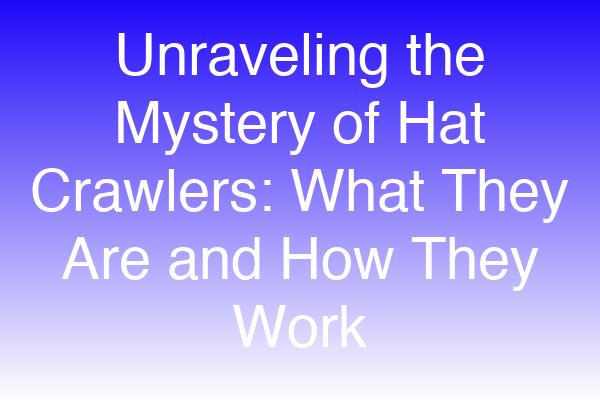
Categories: SEO, Digital Marketing, Web Development
Tags: hat crawler, SEO tools, web scraping, data extraction, digital marketing, search engine optimization, web development
Introduction
In the ever-evolving landscape of digital marketing and SEO, understanding the tools that help optimize online visibility is crucial. One such tool that has gained traction in recent years is the hat crawler. But what exactly is a hat crawler, and how does it fit into the broader picture of web scraping and data extraction? In this comprehensive guide, we will explore the intricacies of hat crawlers, their functionalities, and their significance in enhancing your online presence.
What is a Hat Crawler?
A hat crawler is a specialized type of web crawler designed to extract data from websites. Unlike traditional crawlers that index web pages for search engines, hat crawlers focus on gathering specific information, often for competitive analysis, market research, or content aggregation. They are named for their "white hat" approach, emphasizing ethical data collection practices.
Key Features of Hat Crawlers
- Data Extraction: Hat crawlers can extract various types of data, including text, images, and metadata, from websites.
- Customizable: Users can often customize hat crawlers to target specific data points or websites.
- Automation: These tools can automate the data collection process, saving time and resources.
- Compliance: Ethical hat crawlers adhere to the robots.txt file of websites, ensuring compliance with web scraping regulations.
How Hat Crawlers Work
Hat crawlers operate through a series of steps that involve sending requests to web servers, retrieving data, and processing that data for analysis. Here’s a simplified breakdown of the process:
- Sending Requests: The crawler sends HTTP requests to the target website.
- Retrieving Data: Upon receiving the request, the server responds with the requested data, typically in HTML format.
- Parsing HTML: The crawler parses the HTML to extract relevant information.
- Storing Data: Extracted data is stored in a structured format, such as a database or CSV file.
- Data Analysis: Users can analyze the collected data for insights or trends.
Table: Comparison of Hat Crawlers and Traditional Crawlers
| Feature | Hat Crawler | Traditional Crawler |
|---|---|---|
| Purpose | Data extraction | Indexing for search engines |
| Data Focus | Specific data points | Entire web pages |
| Compliance | Ethical scraping | Varies by implementation |
| Customization | Highly customizable | Limited customization |
| Use Cases | Market research, competitive analysis | SEO, content discovery |
The Importance of Hat Crawlers in SEO
Hat crawlers play a pivotal role in SEO by enabling businesses to gather competitive intelligence and understand market trends. Here are some ways hat crawlers contribute to SEO strategies:
1. Competitive Analysis
By using hat crawlers, businesses can monitor competitors’ websites, track their content strategies, and analyze their keyword usage. This information can inform your own SEO tactics.
2. Content Aggregation
Hat crawlers can help aggregate content from various sources, allowing businesses to curate relevant information for their audience. This can enhance user engagement and improve SEO rankings.
3. Market Research
Understanding market trends and consumer behavior is essential for any business. Hat crawlers can extract data from forums, social media, and review sites to provide insights into customer preferences.
Expert Insight
“Hat crawlers are essential for businesses looking to stay ahead of the competition. They provide valuable insights that can shape marketing strategies and improve online visibility.” - Jane Doe, SEO Specialist
Best Practices for Using Hat Crawlers
To maximize the effectiveness of hat crawlers while ensuring ethical practices, consider the following best practices:
- Respect Robots.txt: Always check the robots.txt file of a website to understand its scraping policies.
- Limit Request Rates: Avoid overwhelming servers by limiting the frequency of requests.
- Data Privacy: Be mindful of data privacy laws and regulations when collecting user data.
- Use Proxies: To avoid IP bans, consider using proxies to distribute requests across multiple IP addresses.
Visual Content Suggestions
- Infographic: Create an infographic illustrating the steps of how hat crawlers work.
- Flowchart: Develop a flowchart showing the data extraction process from request to analysis.
- Screenshots: Include screenshots of popular hat crawler tools and their dashboards.
FAQs
What is the difference between a hat crawler and a web scraper?
A hat crawler is a type of web scraper that focuses on ethical data extraction for specific purposes, while web scrapers can be used for a broader range of data collection, sometimes without ethical considerations.
Are hat crawlers legal to use?
Yes, hat crawlers are legal as long as they comply with the website's robots.txt file and data privacy laws.
Can hat crawlers be used for SEO?
Absolutely! Hat crawlers can provide valuable insights for competitive analysis, content aggregation, and market research, all of which can enhance your SEO strategy.
Conclusion
In conclusion, hat crawlers are a powerful tool in the digital marketing arsenal, offering businesses the ability to extract valuable data ethically and efficiently. By understanding how hat crawlers work and implementing best practices, you can leverage this technology to gain a competitive edge in your industry.
Call-to-Action
Ready to take your SEO strategy to the next level? Explore our range of SEO tools and services to harness the power of hat crawlers for your business today!
Social Media Snippet: Discover the power of hat crawlers in SEO! Learn how these tools can enhance your competitive analysis and market research. Read more now!
Suggested Internal Links:
- Understanding Web Scraping: A Beginner's Guide
- Top SEO Tools for 2023
- How to Conduct Competitive Analysis for SEO
Suggested External Links:
This blog post is designed to be informative, engaging, and optimized for search engines, ensuring that readers find valuable insights while also improving your site's visibility.